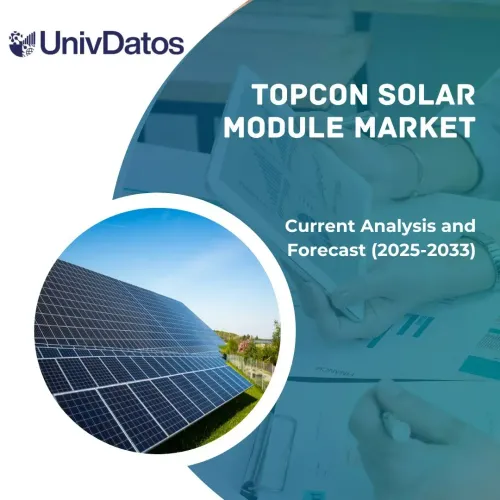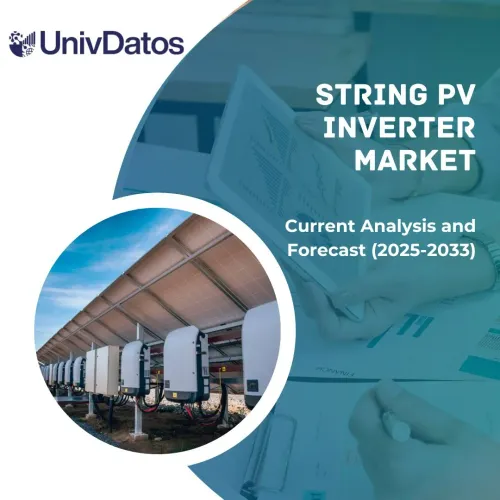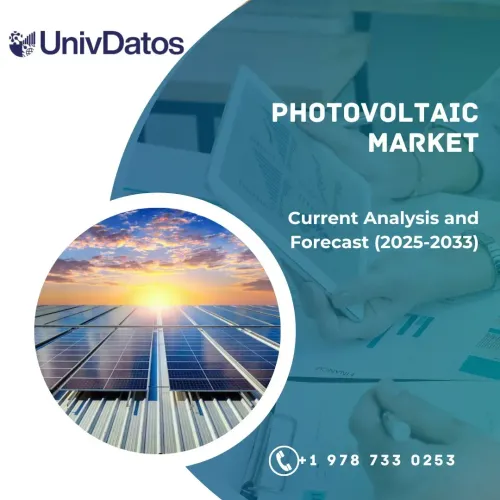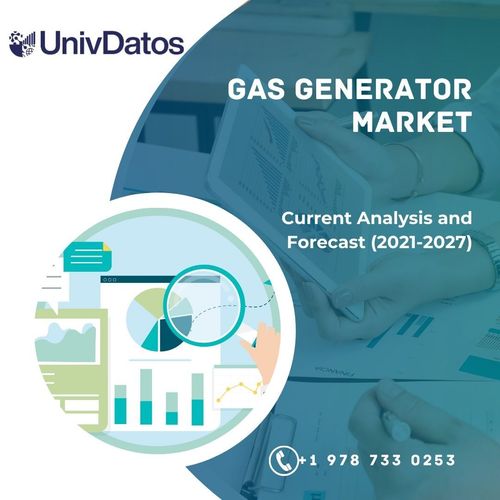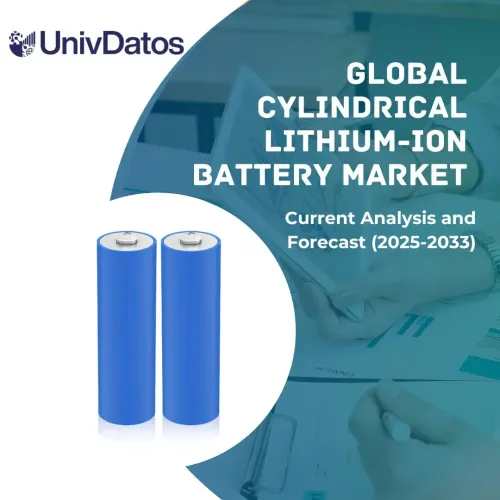- Trang chủ
- Về chúng tôi
- Ngành
- Dịch vụ
- Đọc
- Liên hệ với chúng tôi
Thị trường Pin nhiên liệu trong Hàng không vũ trụ và Quốc phòng: Phân tích hiện tại và Dự báo (2022-2030)
Nhấn mạnh vào Sản phẩm (Pin nhiên liệu ôxít rắn (SOFC) và Pin nhiên liệu màng trao đổi proton (PEMFC)); Ứng dụng (Hàng không dân dụng và Máy bay cánh quạt); và Khu vực/Quốc gia

Thị trường Pin nhiên liệu trong Hàng không vũ trụ và Quốc phòng toàn cầu dự kiến sẽ tăng trưởng với tốc độ chóng mặt khoảng 31% trong giai đoạn dự báo 2022-2030.Pin nhiên liệu là một nguồn năng lượng rất hiệu quả. Nó thường được định nghĩa là một thiết bị điện hóa chuyển đổi nhiên liệu được cung cấp thành năng lượng điện và nhiệt liên tục nếu các chất phản ứng được cung cấp cho các điện cực của nó. Pin nhiên liệu là một trong những tài nguyên năng lượng thay thế phát triển nhanh nhất do khả năng chuyển đổi điện thông qua nhiều loại nhiên liệu. Ngoài ra, pin nhiên liệu là tài nguyên thông thường thân thiện với môi trường, vì các sản phẩm phụ của chúng không gây hại cho thiên nhiên. Do các yếu tố như vậy, chúng được sử dụng rộng rãi trên thị trường hàng không vũ trụ và quốc phòng trên toàn cầu. Ví dụ, vào tháng 3 năm 2021, Công nghệ Pin nhiên liệu cho Máy bay lớn hơn có thể làm giảm lượng khí thải. Ngành hàng không vũ trụ đã chứng minh rằng nó có thể sử dụng pin nhiên liệu cho máy bay nhỏ.Hơn nữa,Ví dụ, vào tháng 11 năm 2022, Airbus đã chuẩn bị cho thử nghiệm bay động cơ pin nhiên liệu hydro cấp megawatt đầu tiên.
Advent Technologies; ElringKlinger AG; Australian Fuel Cells Pty Ltd; Honeywell International Inc.; Infinity Fuel Cell and Hydrogen, Inc.; Loop Energy Inc.; Intelligent Energy Limited; Plug Power Inc.; Cummins Inc; GenCell Ltd là một số người chơi chính trên thị trường. Một số M&A cùng với quan hệ đối tác đã được những người chơi này thực hiện để tạo điều kiện cho khách hàng các sản phẩm/công nghệ công nghệ cao và sáng tạo.
Thông tin chi tiết được trình bày trong Báo cáo
“Trong số các sản phẩm, loại Pin nhiên liệu màng trao đổi proton (PEMFC) dự kiến sẽ tăng trưởng với tốc độ CAGR đáng kể trong giai đoạn dự báo”
Dựa trên sản phẩm, thị trường được phân chia thành Pin nhiên liệu ôxít rắn (SOFC) và Pin nhiên liệu màng trao đổi proton (PEMFC). Loại Pin nhiên liệu màng trao đổi proton (PEMFC) dự kiến sẽ tăng trưởng với tốc độ CAGR đáng kể trong giai đoạn dự báo. Điều này chủ yếu là do quản lý nhiệt tốt hơn, cân bằng nhà máy nhẹ hơn, tuổi thọ xếp chồng ngắn hơn và tính linh hoạt tích hợp hạn chế của PMEFC so với SOFC. Ngoài ra, PEMFC được sử dụng rộng rãi cho các ứng dụng vận tải do hiệu quả, tính nhỏ gọn, phạm vi nhiệt độ và tuổi thọ của nó.
“Trong số các ứng dụng, loại máy bay cánh quạt dự kiến sẽ tăng trưởng với tốc độ CAGR đáng kể trong giai đoạn dự báo”
Dựa trên ứng dụng, thị trường pin nhiên liệu trong hàng không vũ trụ và quốc phòng đã được phân chia thành hàng không dân dụng và máy bay cánh quạt. Loại máy bay cánh quạt dự kiến sẽ tăng trưởng với tốc độ CAGR đáng kể trong giai đoạn dự báo. Máy bay cánh quạt như trực thăng và máy bay cất và hạ cánh thẳng đứng được ưa chuộng trong ngành hàng không vũ trụ và quốc phòng. Ngoài ra, pin nhiên liệu cung cấp một nguồn năng lượng yên tĩnh và hiệu quả và điều đó là rất quan trọng đối với máy bay cánh quạt. Vì chúng yêu cầu công suất đầu ra cao và giảm phát thải tiếng ồn. Ngoài ra, pin nhiên liệu cung cấp độ bền cao hơn, giảm hỗ trợ hậu cần và giảm chi phí vận hành so với các nguồn năng lượng khác.
Phạm vi Báo cáo Thị trường Pin nhiên liệu trong Hàng không vũ trụ và Quốc phòng
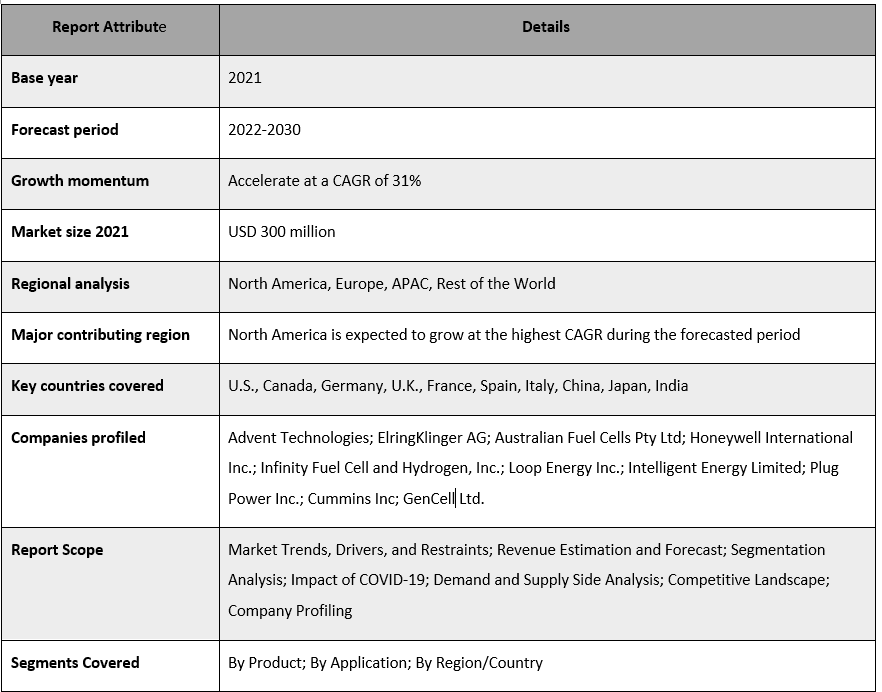
“Bắc Mỹ dự kiến sẽ tăng trưởng với tốc độ CAGR đáng kể trong giai đoạn dự báo”
Năm 2021, Bắc Mỹ dự kiến sẽ tăng trưởng với tốc độ CAGR đáng kể trong giai đoạn dự báo. Điều này chủ yếu là do nhu cầu cao đối với việc phát điện bằng pin nhiên liệu, cũng như việc tăng cường nghiên cứu và phát triển để tạo ra hydro trong khu vực đang thúc đẩy sự tăng trưởng của thị trường. Hơn nữa, Bắc Mỹ có một trong những công ty hàng không vũ trụ và quốc phòng lớn nhất thế giới, bao gồm Boeing, Lockheed Martin và Northrop Grumman, tất cả đều đã đầu tư mạnh vào công nghệ pin nhiên liệu trong những năm gần đây. Vì các công ty này đã đi đầu trong việc phát triển và thử nghiệm các hệ thống pin nhiên liệu cho máy bay và các ứng dụng khác, và việc tiếp tục đầu tư vào công nghệ này đang thúc đẩy tăng trưởng thị trường. Ví dụ, vào tháng 8 năm 2021, Công nghệ Honeywell Mới cho Máy bay không người lái hạng nhẹ đã tăng gấp ba lần phạm vi với Pin nhiên liệu hydro sạch hơn, yên tĩnh hơn. Ngoài ra, Bắc Mỹ có quân đội Hoa Kỳ đang tích cực phát triển và triển khai các UAV chạy bằng pin nhiên liệu và các hệ thống không người lái khác, điều này đã giúp thúc đẩy tăng trưởng thị trường trong khu vực này.
Lý do nên mua báo cáo này:
- Nghiên cứu bao gồm phân tích quy mô và dự báo thị trường được xác nhận bởi các chuyên gia ngành hàng đầu được xác thực.
- Báo cáo trình bày một cái nhìn nhanh về hiệu suất tổng thể của ngành.
- Báo cáo bao gồm phân tích chuyên sâu về các công ty cùng ngành nổi bật với trọng tâm chính là tài chính kinh doanh chính, danh mục sản phẩm, chiến lược mở rộng và sự phát triển gần đây.
- Kiểm tra chi tiết về các động lực, hạn chế, xu hướng chính và cơ hội hiện có trong ngành.
- Nghiên cứu bao gồm toàn diện thị trường trên các phân khúc khác nhau.
- Phân tích cấp độ khu vực chuyên sâu của ngành.
Tùy chọn tùy chỉnh:
Thị trường Pin nhiên liệu trong Hàng không vũ trụ và Quốc phòng toàn cầu có thể được tùy chỉnh hơn nữa theo yêu cầu hoặc bất kỳ phân khúc thị trường nào khác. Bên cạnh đó, UMI hiểu rằng bạn có thể có nhu cầu kinh doanh riêng, do đó, vui lòng kết nối với chúng tôi để có được một báo cáo hoàn toàn phù hợp với yêu cầu của bạn.
Mục lục
Phương pháp nghiên cứu để Phân tích Thị trường Pin nhiên liệu trong Hàng không vũ trụ và Quốc phòng (2022-2030)
Phân tích thị trường lịch sử, ước tính thị trường hiện tại và dự báo thị trường tương lai của thị trường pin nhiên liệu toàn cầu trong hàng không vũ trụ và quốc phòng là ba bước chính được thực hiện để tạo và phân tích việc áp dụng pin nhiên liệu trong hàng không vũ trụ và quốc phòng ở các khu vực chính trên toàn cầu. Nghiên cứu thứ cấp chuyên sâu đã được tiến hành để thu thập các số liệu thị trường lịch sử và ước tính quy mô thị trường hiện tại. Thứ hai, để xác thực những hiểu biết sâu sắc này, nhiều phát hiện và giả định đã được xem xét. Hơn nữa, các cuộc phỏng vấn chính chuyên sâu cũng được tiến hành, với các chuyên gia trong ngành trên toàn bộ chuỗi giá trị của thị trường pin nhiên liệu toàn cầu trong hàng không vũ trụ và quốc phòng. Sau khi giả định và xác thực các con số thị trường thông qua các cuộc phỏng vấn chính, chúng tôi đã sử dụng phương pháp tiếp cận từ trên xuống/từ dưới lên để dự báo quy mô thị trường hoàn chỉnh. Sau đó, các phương pháp phân tích phân tích thị trường và tam giác hóa dữ liệu đã được áp dụng để ước tính và phân tích quy mô thị trường của các phân khúc và phân đoạn phụ của ngành liên quan. Phương pháp chi tiết được giải thích dưới đây:
Phân tích Quy mô Thị trường Lịch sử
Bước 1: Nghiên cứu chuyên sâu về các Nguồn thứ cấp:
Nghiên cứu thứ cấp chi tiết đã được tiến hành để có được quy mô thị trường lịch sử của thị trường pin nhiên liệu trong hàng không vũ trụ và quốc phòng thông qua các nguồn nội bộ của công ty nhưbáo cáo thường niên & báo cáo tài chính, bài thuyết trình hiệu suất, thông cáo báo chí, v.v.,và các nguồn bên ngoài bao gồmtạp chí, tin tức & bài viết, ấn phẩm của chính phủ, ấn phẩm của đối thủ cạnh tranh, báo cáo ngành, cơ sở dữ liệu của bên thứ ba và các ấn phẩm đáng tin cậy khác.
Bước 2: Phân khúc thị trường:
Sau khi có được quy mô thị trường lịch sử của thị trường pin nhiên liệu trong hàng không vũ trụ và quốc phòng, chúng tôi đã tiến hành phân tích thứ cấp chi tiết để thu thập thông tin chi tiết về thị trường lịch sử và chia sẻ cho các phân khúc và phân đoạn phụ khác nhau cho các khu vực chính. Các phân khúc chính được bao gồm trong báo cáo dưới dạng sản phẩm và ứng dụng. Phân tích cấp quốc gia hơn nữa đã được tiến hành để đánh giá việc áp dụng tổng thể các mô hình thử nghiệm trong khu vực đó.
Bước 3: Phân tích nhân tố:
Sau khi có được quy mô thị trường lịch sử của các phân khúc và phân đoạn phụ khác nhau, chúng tôi đã tiến hành một phân tích chi tiếtphân tích nhân tốđể ước tính quy mô thị trường hiện tại của thị trường pin nhiên liệu trong hàng không vũ trụ và quốc phòng. Hơn nữa, chúng tôi đã tiến hành phân tích nhân tố bằng cách sử dụng các biến phụ thuộc và độc lập như các sản phẩm và ứng dụng khác nhau của pin nhiên liệu trong hàng không vũ trụ và quốc phòng. Một phân tích kỹ lưỡng đã được tiến hành đối với các kịch bản cung và cầu có tính đến các quan hệ đối tác hàng đầu, sáp nhập và mua lại, mở rộng kinh doanh và ra mắt sản phẩm trong lĩnh vực thị trường pin nhiên liệu trong hàng không vũ trụ và quốc phòng trên toàn cầu.
Ước tính & Dự báo Quy mô Thị trường Hiện tại
Đánh giá Quy mô Thị trường Hiện tại:Dựa trên những hiểu biết sâu sắc có thể hành động từ 3 bước trên, chúng tôi đã đưa ra quy mô thị trường hiện tại, những người chơi chính trên thị trường pin nhiên liệu toàn cầu trong hàng không vũ trụ và quốc phòng và thị phần của các phân khúc. Tất cả các tỷ lệ phần trăm phân chia cần thiết và phân tích thị trường đã được xác định bằng cách sử dụng phương pháp thứ cấp đã đề cập ở trên và đã được xác minh thông qua các cuộc phỏng vấn chính.
Ước tính & Dự báo:Để ước tính và dự báo thị trường, trọng số đã được gán cho các yếu tố khác nhau bao gồm các động lực & xu hướng, hạn chế và cơ hội dành cho các bên liên quan. Sau khi phân tích các yếu tố này, các kỹ thuật dự báo có liên quan, tức là phương pháp từ trên xuống/từ dưới lên, đã được áp dụng để đưa ra dự báo thị trường cho năm 2030 cho các phân khúc và phân đoạn phụ khác nhau trên các thị trường chính trên toàn cầu. Phương pháp nghiên cứu được áp dụng để ước tính quy mô thị trường bao gồm:
- Quy mô thị trường của ngành, tính theo doanh thu (USD) và tỷ lệ áp dụng của thị trường pin nhiên liệu trong hàng không vũ trụ và quốc phòng trên các thị trường chính trong nước
- Tất cả các tỷ lệ phần trăm, sự phân chia và phân tích chi tiết của các phân khúc và phân đoạn con thị trường
- Các đối tượng chính trên thị trường pin nhiên liệu trong hàng không vũ trụ và quốc phòng toàn cầu về các sản phẩm được cung cấp. Ngoài ra, các chiến lược tăng trưởng được các đối tượng này áp dụng để cạnh tranh trên thị trường đang phát triển nhanh chóng
Xác thực Quy mô và Thị phần Thị trường
Nghiên cứu Sơ cấp:Các cuộc phỏng vấn chuyên sâu đã được tiến hành với các Nhà lãnh đạo Ý kiến Chính (KOL) bao gồm các Nhà điều hành Cấp cao (CXO / VPs, Trưởng phòng Kinh doanh, Trưởng phòng Tiếp thị, Trưởng phòng Vận hành, Trưởng phòng Khu vực, Trưởng phòng Quốc gia, v.v.) trên các khu vực chính. Các phát hiện nghiên cứu sơ cấp sau đó đã được tóm tắt và phân tích thống kê đã được thực hiện để chứng minh giả thuyết đã nêu. Đầu vào từ nghiên cứu sơ cấp được hợp nhất với các phát hiện thứ cấp, do đó biến thông tin thành những hiểu biết có thể hành động.
Phân chia những Người tham gia Sơ cấp ở Các khu vực Khác nhau
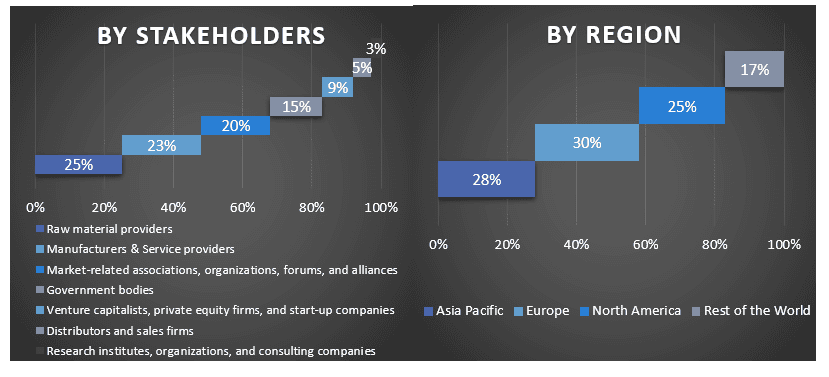
Kỹ thuật Thị trường
Kỹ thuật tam giác dữ liệu đã được sử dụng để hoàn thành ước tính thị trường tổng thể và để đưa ra các con số thống kê chính xác cho từng phân khúc và phân đoạn con của thị trường pin nhiên liệu trong hàng không vũ trụ và quốc phòng toàn cầu. Dữ liệu đã được chia thành một số phân khúc và phân đoạn con sau khi nghiên cứu các thông số và xu hướng khác nhau trong các lĩnh vực sản phẩm và ứng dụng trên thị trường pin nhiên liệu trong hàng không vũ trụ và quốc phòng toàn cầu.
Mục tiêu chính của Nghiên cứu Thị trường Pin nhiên liệu trong Hàng không vũ trụ và Quốc phòng Toàn cầu
Các xu hướng thị trường hiện tại và tương lai của thị trường pin nhiên liệu trong hàng không vũ trụ và quốc phòng toàn cầu đã được xác định trong nghiên cứu. Các nhà đầu tư có thể thu được những hiểu biết chiến lược để dựa vào quyết định đầu tư của họ vào phân tích định tính và định lượng được thực hiện trong nghiên cứu. Các xu hướng thị trường hiện tại và tương lai đã xác định sức hấp dẫn tổng thể của thị trường ở cấp độ khu vực, cung cấp một nền tảng cho người tham gia công nghiệp khai thác thị trường chưa được khai thác để hưởng lợi từ lợi thế đi đầu. Các mục tiêu định lượng khác của các nghiên cứu bao gồm:
- Phân tích quy mô thị trường hiện tại và dự báo của thị trường pin nhiên liệu trong hàng không vũ trụ và quốc phòng theo giá trị (USD). Ngoài ra, hãy phân tích quy mô thị trường hiện tại và dự báo của các phân khúc và phân đoạn con khác nhau
- Các phân khúc trong nghiên cứu bao gồm các lĩnh vực sản phẩm và ứng dụng.
- Xác định và phân tích khuôn khổ pháp lý cho pin nhiên liệu trong hàng không vũ trụ và quốc phòng
- Phân tích chuỗi giá trị liên quan đến sự hiện diện của các trung gian khác nhau, cùng với việc phân tích hành vi của khách hàng và đối thủ cạnh tranh trong ngành.
- Phân tích quy mô thị trường hiện tại và dự báo của thị trường pin nhiên liệu trong hàng không vũ trụ và quốc phòng cho khu vực chính.
- Các quốc gia chính của các khu vực được nghiên cứu trong báo cáo bao gồm Châu Á Thái Bình Dương, Châu Âu, Bắc Mỹ và Phần còn lại của Thế giới.
- Hồ sơ công ty của thị trường pin nhiên liệu trong hàng không vũ trụ và quốc phòng và các chiến lược tăng trưởng được những người tham gia thị trường áp dụng để duy trì trên thị trường đang phát triển nhanh chóng
- Phân tích chuyên sâu cấp độ khu vực của ngành
Liên quan Báo cáo
Khách hàng đã mua mặt hàng này cũng đã mua


